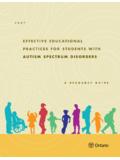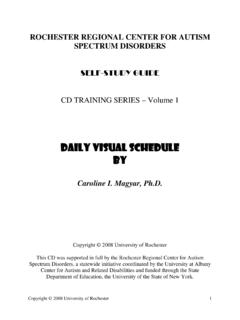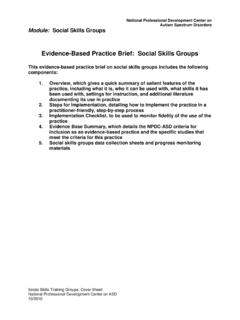Transcription of Nonverbal Imitation - Autism Partnership Australia
1 Nonverbal Imitation153 Nonverbal learns to imitate the actions of becomes the foundation upon which other importantskills are based ( , verbalization, play, social, self-help, etc.) is the basis for modeling which is a very important typeof facilitates a positive relationship between Student andteacher ( , being like the teacher becomes reinforcing) builds awareness of the helps develop attending is a simple task that can be used to establish or reestablishcompliance and attention. It allows Student to easily earn rein-forcementProcedure:The teacher demonstrates an action and says do this.
2 Student is tomirror the action of the teacher ( if teacher uses right hand, he shoulduse his left hand). The phases start with obvious large actions andprogress to more subtle and refined movements. Imitations involving themanipulation of a physical object (dropping a block in a bucket) or pro-duce discrete sensory feedback (ringing a bell) are generally easier to that involve moving body parts away from the body ( , arms out toside) or a part of the body he cannot directly see ( , nose, head) are Student progresses, the verbal cue will be generalized to other phraseswhich have the same meaning as Do this ( , do what I m doing , copy me , etc.)
3 As a final step, the action will be named ( , Claphands ). This builds the knowledge base for following verbal directions. Do this is used at first to establish the concept of Imitation , an essentialskill that provides a nonlanguage-based means of teaching a variety ofother Autism Partnership Curriculum for Discrete Trial teaching with Autistic ChildrenPrompts:Use physical guidance to move Student through the action. Graduallyfade the prompt to a light touch and then a slight criter:There are no prerequisites for this skill. It is one of the simplest skills wecan teach. In-seat behavior and eye contact can usually be shaped at thesame time this skill is being crit:Student performs a response eight out of ten times correctly with noprompting.
4 This should be repeated with at least one additional 1:Start with items that involve the manipulation of an object. Teacheach one individually in isolation. This means doing repeated trials of justthat item with no other object in view. Once Student is successfully per-forming an action without prompting, then move in one or more distractoritems on each trial. Also, each item needs to be used in more than oneway in order to build attention and establish a discrimination. For ex-ample, some times you should drop the hammer in the bucket, instead ofusing it to pound the pegs in. Once two items are able to be rotated ran-domly, introduce a new item.
5 As each one is mastered in isolation itshould be randomized with all previously taught ManipulationBlock in containerRing bell (shake or tap)Pop up toyStir spoon in bowlBang drumThrow bean bagRing on cylinderComb/brush hairPut on hatWave streamerShake tambourinePop-up toyTap table with blockSpin top (press down)Stack blockHonk hornRaise cup to mouthPull leverShake snow globeTap sticksRoll carCrash carPut on sunglassesClap with blocksLoad/unload dump truckThrow ballPlay pianoRock dollAnswer phoneBlow whistlePhase 2:Start when Student has mastered five items from Phase 1. Choosethree items from large motor list.
6 As each one is mastered, add an addi-tional item for training. Sitting down should not always be the responsethat follows standing up. For example, you can have Student clap hishands while Imitation155 Large Motor:Raise armsArms out to sideClap handsStamp feetTouch noseWave bye-byePat tummyTouch mouthPat headSlap kneesCover ears with handsPull hairTouch elbowTouch eyesTap shouldersTouch toesTab table with handStand upPhase 3:Imitations away from chair. Start when Student has learned five itemsfrom Phase 2. Teach responses that involve going to a location away fromthe chair, carrying out an action and returning to the chair.
7 Student shouldremain in the chair until teacher has finished demonstrating the action andhas returned to the on doorTouch spot on wall withMarch extended handDrop marble down chuteLook out windowMark on chalkboardPut item on shelfPut object in drawerOpen/close drawerTurn on/off lightThrow item in trashRoll car down rampPut doll to bedPut shape in sorterPhase 4:Imitates another person. Teacher indicates someone for Student toimitate and says, Do that. Phase 5:Once five large motor items are learned (Phase 2), add fine Motor:Squeeze PlaydohRoll PlaydohTouch chinTouch mouthTouch eyesTouch earsPick up penny &Push button drop in jarPut small pegs in boardMake OK signDrumroll fingers on tableMake victory signThumbs upPinch clothespinSqueeze squeaky toyPointSpin top (with fingers)This is an appropriate stage to begin oral-motor Imitation .
8 See the VerbalImitation, Phase 2 (oral-motor Imitation ).156 The Autism Partnership Curriculum for Discrete Trial teaching with Autistic ChildrenPhase 6:Continuous chain. Once ten imitations are learned from Phase 2, haveStudent follow along with you as you link together a series of the responses to maintain interest and attention and promote gener-alization. Start with two or three responses and then continue on withlonger chains. The goal is to give a single verbal cue and defer reinforce-ment until the chain is 7:Advanced Imitation . Once ten imitations are learned from Phase 2 andfive from Phase 5, go on to finer Examples:Raise one vs.
9 Two armsTouch nose with one finger vs. whole handWave bye-bye with right vs. left handTap once vs. two timesClap high vs. clap lowPhase 8:Two-step chains. This requires the use of memory. Once 20 responsesare mastered from any of Phases 1-7, begin chaining responses togetherinto two-step responses ( , put on hat and knock on door). Start withitems taught in Phases 1 and 3. Demonstrate both responses while Studentwatches. If necessary, prompt him to wait until the second action is com-pleted. Then have him perform the two responses. Once he is good atresponses from Phases 1 and 3, begin using items trained in phases 2 and 5( , clap hands and slap knees).
10 Phase 9:Crossing over ( , touch right leg with left hand; touch left shoulderwith right hand)Phase 10:Two responses at once ( , touch shoulder with right hand and kneewith left hand; crossing arms)Phase 11:Three-step chains. Same as Phase 8, but Student performs three stepsinstead of 12:Imitates action in video. Present visual stimulus and tell Student, Dothis. discrete action (simultaneous) action (simultaneous) chai









